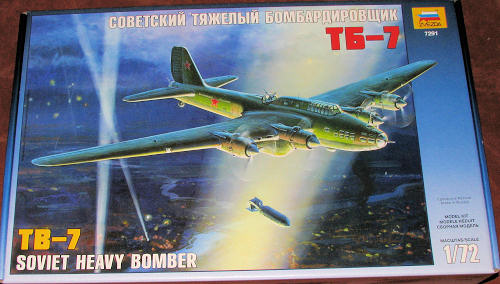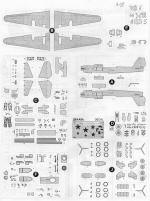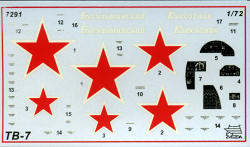
Zvezda 1/72 TB-7 Heavy Bomber
| KIT #: | 7291 |
| PRICE: | $44.50 SRP |
| DECALS: | One Option |
| REVIEWER: | Scott Van Aken |
| NOTES: |

| HISTORY |
Development of Pe-8 was initiated in the Tupolev's OKB as ANT-42 in July 1934. The maiden flight of the first prototype was in December 1936 by M.M.Gromov. The aircraft actually has five engines - an auxiliary M-100 ATsN-2 was fitted inside the airframe. This drove a supercharger to supply pressurized air to the main engines.
Only 93 or 96 (including two prototypes) were built from 1936-1944 - older sources claim a number of 81 including prototypes, with production stopping in 1940; this seems to indicate that indeed only replacement aircraft were built after 1940. Some had Charomski M-30B/ACh-30B or M-40/ACh-40 diesel engines and the later aircraft were fitted 1,380 kW (1,850 hp) Shvetsov ASh-82 radials due to low availability of the AM-35A. These radial engine aircraft were sometimes known as the TB-7. Neither variant was as successful as the original, the diesel engines giving poorer performance and the radial delivering better performance but often being unreliable. It is a testimony to the soundness of the design however, that the examples which survived WWII were retained in service until the late 1950s despite the availability of the Tu-4. Altogether, the Pe-8, despite suffering from low priority of the strategic bombing role in the USSR military doctrine of its time and problems with the engines, compares well with other four-engine bombers designed in the late 1930s.
From a technical standpoint, the Pe-8 is remarkable because it had defensive machine-gun positions installed in the rear of the inboard engine nacelles. These were deleted when the nacelles were reconstructed for accommodation of the radial engines.
The USSR had no plans for strategic bombardment, and only a few Pe-8 attacks on Germany were flown, the first in early August, 1941 (only weeks after the German attack on the USSR had started), when aircraft of the 81 DBAD (Long Range Bomber Division) bombed Berlin. Most Pe-8 attacks on Berlin were 'nuisance' bombings involving only a handful of aircraft (e.g. 14 in the first raid). It was used in the strategic bomber role to attack targets in German-held Eastern Europe and as a tactical bomber to support ground forces in the battles of Stalingrad and Kursk. The Pe-8 at first equipped a single bomber regiment, the 432 BAP (ON) (432nd Special Bomber Regiment) and its reserve unit, the 433rd; they were later reorganized into the 746 and 890 BAP (bomber regiment).
The Pe-8's most important claim to fame is flying Soviet foreign minister Molotov and his delegation from Moscow to London and Washington DC and back for talks on the opening of a second front against Nazi Germany (May 19th-Jun 13th, 1942), on the return trip crossing German-controlled airspace without incident.
| THE KIT |
 This
is, by my count, the third release of the base Pe-8 kit. This time it is the
radial engine version, sometimes called the TB-7. As you can imagine, the
difference in the sprues is geared towards the engine and prop and nacelle, so
the J sprue has been added to take care of these differences. All the other
sprues are still there, though the nacelle sprues for the Pe-8 boxings are not
included.
This
is, by my count, the third release of the base Pe-8 kit. This time it is the
radial engine version, sometimes called the TB-7. As you can imagine, the
difference in the sprues is geared towards the engine and prop and nacelle, so
the J sprue has been added to take care of these differences. All the other
sprues are still there, though the nacelle sprues for the Pe-8 boxings are not
included.
The molding of this kit is superb, reminding one very much of current Hasegawa kits with the crisp, engraved panel lines and the use of decals for instrument panels! The large and sturdy cardboard box opens like those much maligned Pro-Moldeler boxes when that line first appeared. However, these are quite sturdy and should do well to hold the bits one is working on. A lesson learned from earlier kits is that the sprues are all packed in separate bags. Though they are not sealed, there was no damage and no sprues 'leaked' out of the bags.
 Detailing
on the inside of the various parts is very good. I found no sink areas, no
flash, and it appears that the kit has been engineered so that ejector pin
towers will be invisible once the kit is built. A real anomaly when it comes to
modern kits is that there are crew figures supplied. Not only that, but many of
them have separate head and arms, so they can be positioned. As you may well
understand, there are holes to open up for the different versions, and this
includes some windows and doors in the fuselage. There are no options other than
gear and bomb bay open or closed. For the bomb bay, a single very large bomb is
provided. One thing that is provided is a pretty complete cockpit and interior
with a floor included in all the appropriate sections of the plane. Not sure how
much will be visible through the small windows, but the clear plastic is well
molded and quite transparent.
Detailing
on the inside of the various parts is very good. I found no sink areas, no
flash, and it appears that the kit has been engineered so that ejector pin
towers will be invisible once the kit is built. A real anomaly when it comes to
modern kits is that there are crew figures supplied. Not only that, but many of
them have separate head and arms, so they can be positioned. As you may well
understand, there are holes to open up for the different versions, and this
includes some windows and doors in the fuselage. There are no options other than
gear and bomb bay open or closed. For the bomb bay, a single very large bomb is
provided. One thing that is provided is a pretty complete cockpit and interior
with a floor included in all the appropriate sections of the plane. Not sure how
much will be visible through the small windows, but the clear plastic is well
molded and quite transparent.
 Interestingly, the instructions do not start with the
cockpit, deciding that it is more important to get the wings and internal
detailing build up first. There are 47 well drawn construction steps, each
providing paint information based on Model Master references. Markings are
provided for one aircraft as shown on the box art. The plane is in a four color
scheme of black, brown, green over light blue and shown as a donation aircraft assigned to the
25 Guards
Regiment in 1943. The decals are well printed, but one should be somewhat
cautious when applying them as Zvezda decals have not always worked well for me.
Interestingly, the instructions do not start with the
cockpit, deciding that it is more important to get the wings and internal
detailing build up first. There are 47 well drawn construction steps, each
providing paint information based on Model Master references. Markings are
provided for one aircraft as shown on the box art. The plane is in a four color
scheme of black, brown, green over light blue and shown as a donation aircraft assigned to the
25 Guards
Regiment in 1943. The decals are well printed, but one should be somewhat
cautious when applying them as Zvezda decals have not always worked well for me.
| REFERENCES |
http://en.wikipedia.org/wiki/Petlyakov_Pe-8
June 2012
Thanks to www.dragonmodelsusa.com for the preview kit. Get this very reasonably priced kit at your local shop or have them order it for you.
If you would like your product reviewed fairly and fairly quickly , please contact me or see other details in the Note to Contributors.